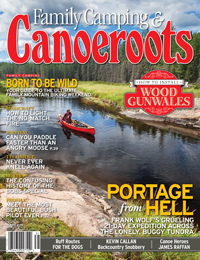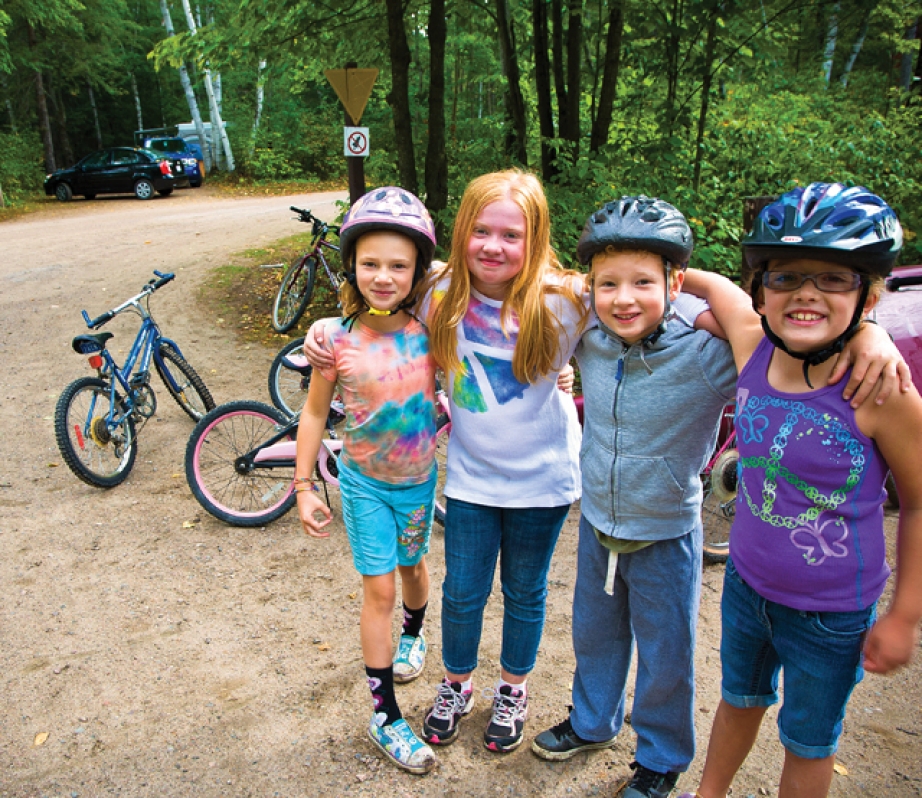Whether mountain biking is your middle name or something you’ve discovered in middle-age, trail riding is a fun-for-the-whole-family activity that puts a spin on weekend camping. From behind the bars, kids will find navigating trails a new adventure. This go-to guide will help you choose the bikes, trails and gear to suit even the littlest rippers.
BIKE FIT: THINK LITE
Kids learn more quickly and enjoy riding more when they’re on well-designed, well-built bikes. Most major bike manufacturers, such as Specialized, Trek, Rocky Mountain and Norco, now offer decent kids’ bikes in 16-inch, 20-inch and 24-inch wheel sizes. Designers take height, weight, proportions and strength of kids into consideration. Being able to apply the brakes and shift the gears with smaller hands is key to enjoying the experience and being able to trail ride as a family.
“When you’re choosing bikes for kids, weight is the biggest factor,” suggests Duncan Beard, bike guru and bike racer from Fresh Air Experience bike shop. Lighter bikes are simply easier to pedal and allow kids more control, which is especially important if you’re heading over the hills and far away.
As a guideline, Beard recommends bikes weigh no more than a third of a child’s weight. “If your kid is less than 100 pounds, their bike shouldn’t weigh more than 30 pounds.” He encourages parents to forgo shocks for kids under 10 years old to save weight.
This, however, is easier said than done, found Canoeroots publisher Scott MacGregor. “The best kids bikes we could find weighed more than our adult-sized bikes. It hardly seems fair.” Frame size isn’t as much of a factor as the rest of the bike’s components. “There is a big difference between department store bikes and good quality, $500 kids’ mountain bikes,” says MacGregor, “but it’s still a far cry from what’s standard on a $1,500 adult mountain bike.” If you’re really serious about setting up your kids with lighter weight bikes, MacGregor suggests looking at racing BMX models or starting with an aluminum-framed mountain bike and making a hobby out of upgrading parts.
It seems like a no-brainer, but Beard also advocates for selecting a bike that fits. “If you get a bike that you hope they’ll grow into, it will be hard for them to ride it and enjoy it now,” he says.
Well-made bikes are worth the initial investment. They come with components that operate more smoothly and require less maintenance than anything from Walmart—think more riding and less tinkering with shifters and brakes. A good new bike will last to be handed down through siblings or can be sold or traded when the time comes to upsize.
PUMP UP FOR TRAILS
Kids deal with frustration and fatigue differently depending on their endurance, ability and temperament. Figure out how fast, how far and how long your kids are ready to bike by taking interesting rides close to home. A few of these will help you plan realistic weekend adventures. With kids, distance is often less of a factor than time in the saddle. On days when there’s heat, rain, steep hills or bugs, assume that part of your children’s stamina will be spent on coping with their environment.
It’s up to parents to keep an arsenal of distractions, diversions and motivation in their pack pocket to dole out and keep spirits high. Try sing-a-longs, games, snacks or exciting destinations along the way—anything to avoid hearing, “How much further?”
Every child is different of course, but experienced kids around the age of six are usually able to last about 45 minutes on their own, over gentle terrain. Double that if they’re riding behind you on a trail-a-bike. For many experienced 10-year-olds, an hour and a half on their own bike is no problem. Almost everyone prefers a loop to the repetitiveness of an out-and-back route.
“Most adults want to set goals, in terms of distance, time or effort and that’s not going to work with kids,” says Lee McCormack of Boulder, Colorado, author of Teaching Mountain Bike Skills. “The terrain shouldn’t be threatening at all,” he advises for newbie kids. “We want to imprint positive experiences, so keep it very mellow.” He adds that completely flat trails aren’t ideal because kids love to coast down hills, instead, opt for moderate grade, simple open track, with some rocks to make things interesting.
McCormack is a father of twin three-year-old girls. He got his kids started on Strider bikes when they were just 18 months old. “They just chewed on them at first, but when they were two, they wanted to ride them.” McCormack advocates pump tracks—mini, circular, off-road routes that take riders over bumps and through tight corners and can even fit inside a backyard. “Parents don’t want to give up riding but can’t take their kids on a three-hour, cross country, Type A mission,” says McCormack. “Pump tracks are the answer. They’re a great place to hang out and there’s a huge benefit in terms of athleticism and fitness.”
Pump tracks are like a low-key BMX track from the ‘80s and they’re springing up in municipal parks everywhere. There’s probably one near you. Before hitting the trails, laps at a pump track can help your kids learn to corner on berms and pedal hard up steep rollers. No one gets left behind at the pump track and kids can stop for a snack or play whenever they want.
SMOOTH, FLOWING TRAILS ENCOURAGE ENW RIDERS
Now that there’s a trail the whole family can enjoy, trailbuilder Ted Ferguson has noticed a huge increase in the number of ski families out mountain biking at Mont Ste-Marie, north of the city of Gatineau, Quebec.
“The very first trail the other dads and I built goes straight down a steep hill. It’s pretty advanced,” laughs Ferguson who obtained a grant to build a five-kilometer beginner mountain bike loop. “If a family is looking to mountain bike, trail conditions are an absolute priority. Rooty, swampy, rocky or too steep isn’t fun for a lot of young kids, especially if they’re just getting into biking.” Everything is to scale. Two-inch roots and rocks we roll over are a much bigger deal on a bike with small 20-inch wheels, he says.
In order to make the trail fun for kids and beginner riders while still offering challenges for advanced riders, Ferguson and trail builders across the country are making smooth trails and adding berms at every turn.
“You need flow and fun. Challenging, but not too challenging,” says Ferguson who carries his younger son’s bike up hills to hook the boy on downhill thrills. “The berms turn the trail into a roller coaster that kids love. And it creates a beautiful, fluid sensation for experienced riders,” he adds.
FUEL UP
Food that’s filling and delicious and stays appetizing after being jostled in a backpack works best. Hard-boiled eggs, hummus and veggies, apples, wraps and treats like cookies or granola bars will be favorites.
Don’t overthink your food selection, whatever you would usually bring on a hike works on a bike ride. Avoid energy goos or fancy sports bars that are marketed to endurance athletes. Many of these products contain caffeine as a performance-enhancing ingredient and are not appropriate for the younger set.
BIKE BASE CAMPING
The perfect bike weekend campsite offers lots of opportunities for the kids to relax and play. If you’re staying in a campground, choose a site close to a beach, a big soccer field, a playground with a fun set of monkey bars or any other interesting features. Especially after using a lot of balance and control on the bike, kids need to let loose and play in the evening.
Choosing a campsite close to the trails means adults can take turns hanging out with the kids and heading out for their own quick, intense trail rides.
Don’t put the bikes away after the trail ride. Riding the paths around the campground may be even more fun for them. “We set boundaries, remind them of cars, hand them walkie talkies and they’re gone,” says MacGregor. “Riding a bike is the closest to real freedom a kid can get.”
Kathleen Wilker and her family are avid cyclists. In 2010 Kathleen was awarded the City of Ottawa’s Bruce Timmermans Award for cycling education and promotion.





